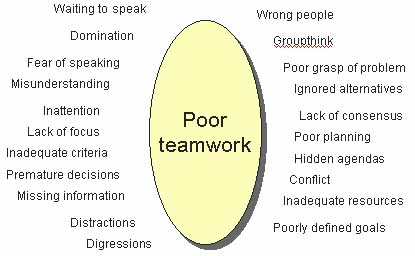
Process support
Process structure
Task support
Task structure
Meeting Works
GroupSystems
Matching tools with meetings
Before, during and after the meeting
Failure to understand goals
Lack of participation, domination, misunderstandings
Expensive

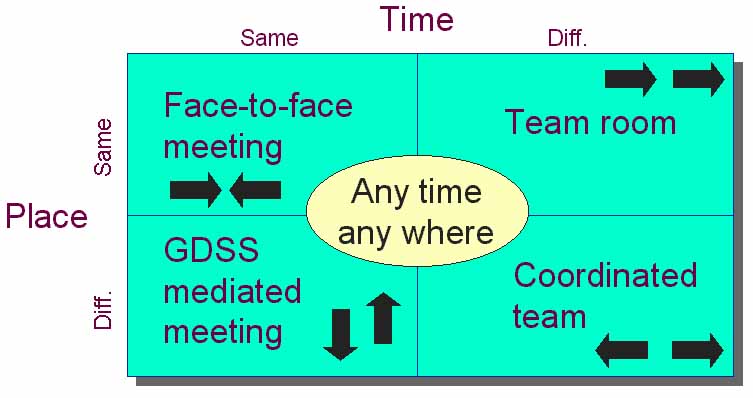
Agenda planner (prior definition of steps, by the facilitator)
Generate
Organise
Evaluate
Cross Impact analysis
Multiple Criteria Analysis
Timer
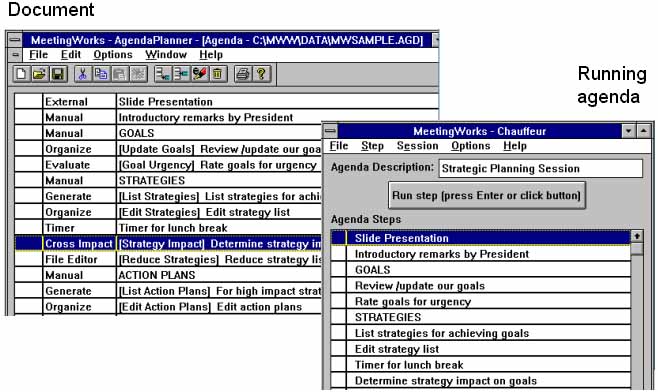
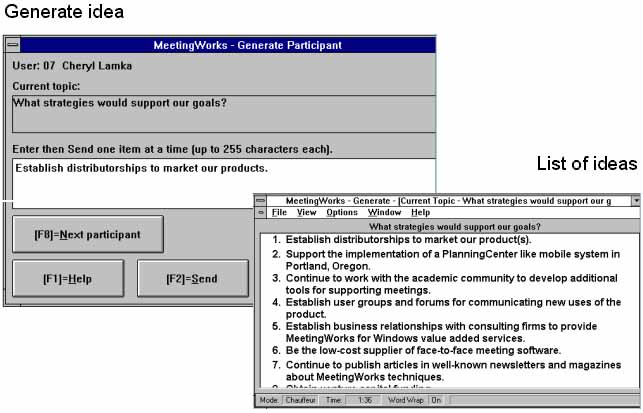
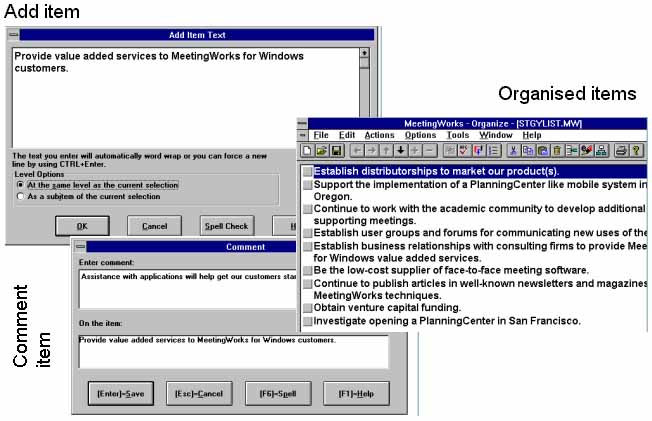

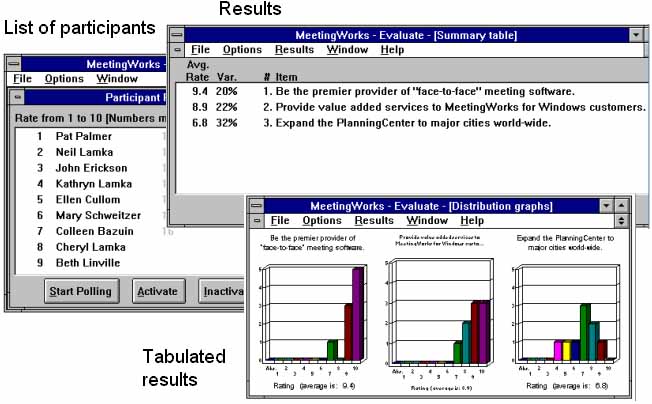
Idea generation
Idea organisation
Selection/evaluation
Analysis/planning
Specific tools (e.g. re-engineering)
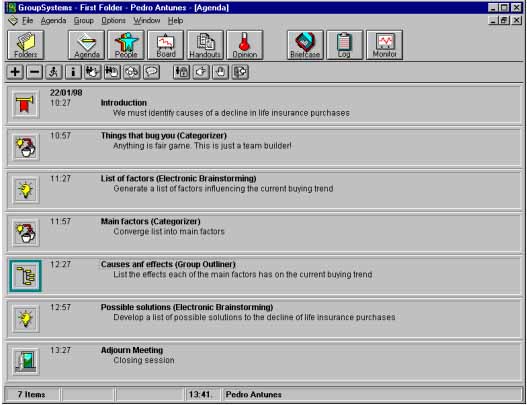
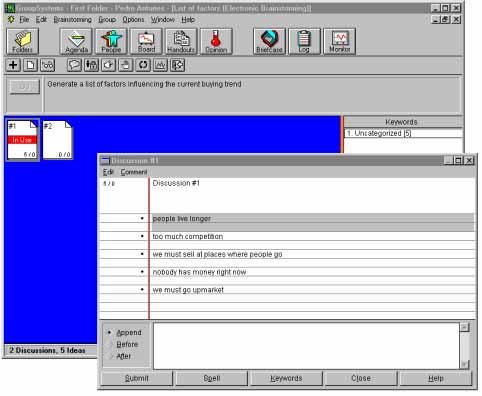
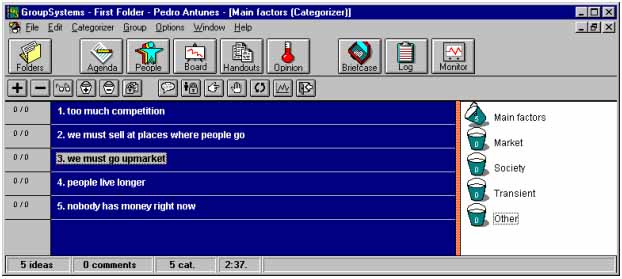
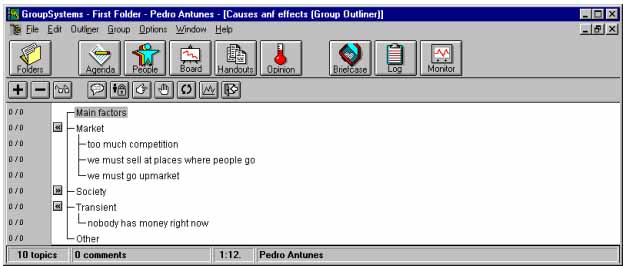
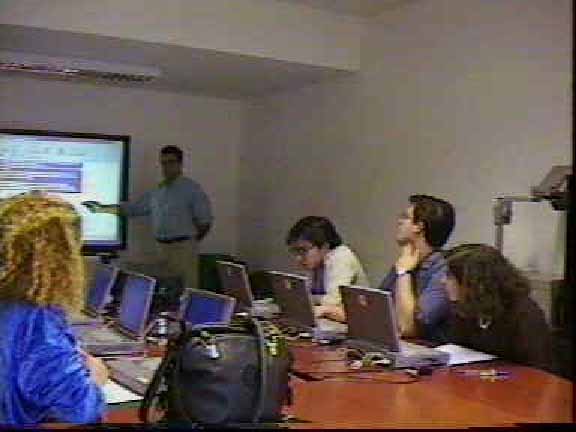
Brainstorming - Generate items
Clarifying - Generate comments on items
Categorising - Define categories for items
Evaluation process
Identify pros and cons
Define criteria and measure items against criteria
Consensus strategies
Combine items
Identify areas of agreement and disagreement
Negotiate
Vote
Problem-solving processes
Goals
Barriers - Identify parameters, criteria and issues
Alternatives - Identify potential resources and solutions
Select - Evaluate solutions, choose solution
Sequence - Define action plan, people and resources
What will we do?
How will we do it?
When will it be done?
Who will do it?
What resources are needed?
How to measure results?
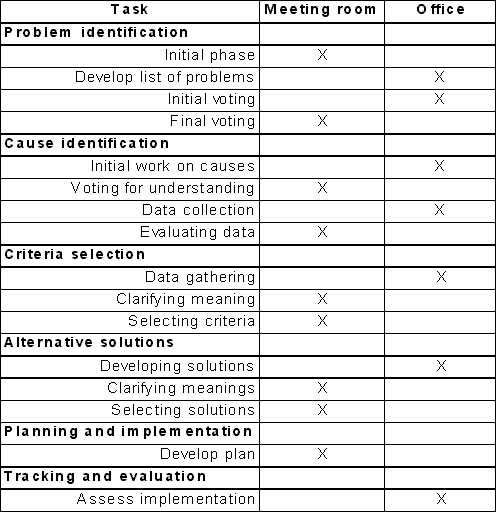
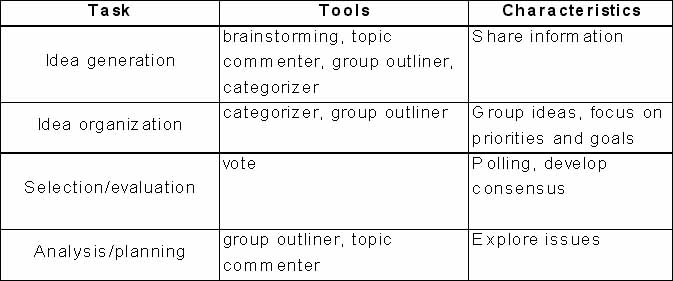
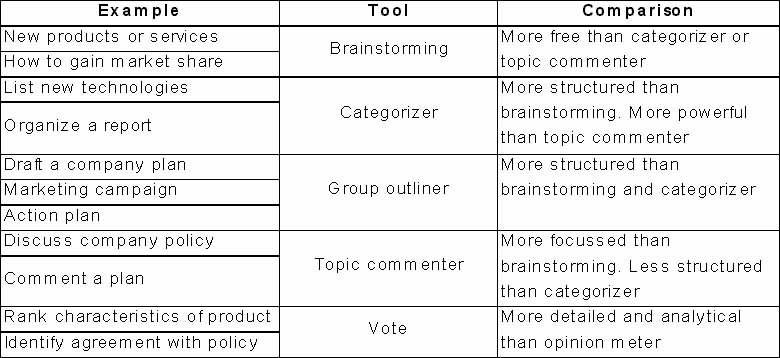
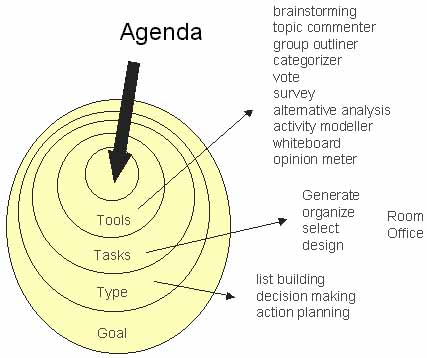
Start/stop tools
Re-configure tool settings
Change agenda and tool functionality according to participants intentions
Follow facilitation guidelines for conducting meeting
Apply facilitation techniques when intervening
Anticipate events
Have a contingency plan
Usefulness
Satisfaction
Coverage of topics
Can make a well-planned meeting better and a poorly-planned meeting worse
Can reduce 50% labour costs and 90% project time
Individuals must have incentives to participate
Can increase number of ideas generated
Increases energy and group focus
Anonymity encourages objectivity
Anonymous criticism improves quality of ideas
Build independent special-purpose modules
Subtle differences in user-interface have strong impact in the group
Provide short learning curve
Provide both task and process support
Can be used to clarify, focus discussion, reveal consensus and stimulate thinking
Anonymity brings buried issues
Can demonstrate areas of agreement
Can close issues too painful to face at
Methods need not be democratic
Public screen is important to focus attention
Provide visual line of sight and desktop space
Provide individual space for reflection
Pre-session planning is critical
Group must always see where they are headed to
Focus must be on group rather than technology
Small changes in tool setup make big differences in group dynamics
Expect agenda to be changed
Mix modes between verbal and computer-supported interaction
[DeSanctis 87] DeSanctis, G., Gallupe, R. 1987. A Foundation for the Study of Group Decision Support Systems. Management Science, 33(5).
[Nunamaker 91] Nunamaker, J., Dennis, A., Valacich, J., Vogel, D., George, J. 1991. Electronic meeting systems to support group work. Communications of the ACM, 34(7).
[Bostrom 92] Bostrom, R., Watson, R., Kinney, S. (eds), Computer Augmented Teamwork. Van Nostrand Reinhold.
[Nunamaker 97] Nunamaker, J., Briggs, R., Mittleman, D., Vogel, D., Balthazard, P. 1997. Lessons from a Dozen Years of Group Support Systems Research: A Discussion of Lab and Field Findings. Journal of Management Information Systems. V. 13 N. 3. Winter.
[Pinsonneault 89] Pinsonneault, A., Kraemer, K. 1989. The Impact of Technological Support on Groups: An Assessment of the Empirical Research. Decision Support Systems. N. 5.
[Turoff 91] Turoff, M. 1991. Computer-Mediated Communication Requirements for Group Support. Journal of Organizational Computing, 1(1).
[Patton 89] Patton, B., Giffin, K., Patton, E. 1989. Decision Making Group Interaction. Harper Collins Publishers.
[Johanson 91] Johansen, R., Sibbet, D., Benson, S., Martin, A., Mittman, R., Saffo, P. 1991. Leading Business Teams. Addison-Wesley.
[Hwang 87] Hwang, C., Lin, M. 1987. Group Decision Making under Multiple Criteria: Methods and Applications. Springer-Verlag.
[Whitaker 94] Whitaker, R. 1994. GDSS' Formative Fundaments. Computer Supported Cooperative Work, 2.
[Applegate 91] Applegate, L. 1991. Technology Support for Cooperative Work: a Framework for Studying Introduction and Assimilation in Organizations. Journal of Organizational Computing, 1(1).
[Anson 96] Anson, R., Fellers, J., Kelly, G., Bostrom, R. 1996. Facilitating Research with Group Support Systems. Small Group Research. V. 27. N. 2.
[Applegate 91] Applegate, L. 1991. Technology Support for Cooperative Work: a Framework for Studying Introduction and Assimilation in Organizations. Journal of Organizational Computing, 1(1).
[Ackerman 95] Ackerman, M., Starr, B. 1995 (Nov.). Social Activity Indicators: Interface Components for CSCW Systems. Proceedings of the ACM Symposium on User Interface Software and Technology. ACM, Pittsburg.
[Beaudouin-Lafon 92] Beaudouin-Lafon, M., Karsenty, A. 1992 (Nov.). Transparency and Awareness in a Real-Time Groupware System. Proceedings of the ACM Symposium on User Interface Software and Technology. ACM, Monterey, California.
[Benford 93] Benford, S. 1993 (Sep.). A Spatial Model of Interaction in Large Virtual Environments. Proceedings of the Third European Conference on Computer-Supported Cooperative Work - ECSCW '93.
[Conklin 88] Conklin, J. 1988. Gibis: a Hypertext Tool for Exploratory Policy Discussion. Proceedings of the Conference on Computer-Supported Cooperative Work CSCW '88. Portland, Oregon: ACM Press.
[DeSanctis 87] DeSanctis, G., Gallupe, R. 1987. A Foundation for the Study of Group Decision Support Systems. Management Science, 33(5).
[Eden 93] Eden, C. 1993. Strategy Development and Implementation: Cognitive Mapping for Group Support. Chap. 5: Strategic Thinking: Leadership and the Management of Change. John Wiley & Sons, Ltd.
[Edmonds 94] Edmonds, E., Candy, L., Jones, R., Soufi, B. 1994. Support for Collaborative Design: Agents and Emergence. Communications of the ACM, 37(7).
[Ellis 91] Ellis, C., Gibbs, S., Rein, G. 1991. Groupware: Some Issues and Experiences. Communications of the ACM, 34(1).
[Greif 94] Greif, I. 1994. Desktop Agents in Group-Enabled Products. Communications of the ACM, 37(7).
[Haake 94] Haake, J., Neuwirth, C., Streitz, N. 1994 (Sep.). Coexistence and Transformation of Informal and Formal Structures: Requirements for More Flexible Hypermedia Systems. ACM European Conference on Hypermedia Technology ECHT '94.
[Hiltz 93] Hiltz, S., Turoff, M. 1993. The Network Nation. MIT Press.
[Hwang 87] Hwang, C., Lin, M. 1987. Group Decision Making under Multiple Criteria: Methods and Applications. Springer-Verlag.
[Ishii 94] Ishii, H., Kobayashi, M., Arita, K. 1994. Iterative Design of Seamless Collaboration Media. Communications of the ACM, 37(8).
[Johanson 91] Johansen, R., Sibbet, D., Benson, S., Martin, A., Mittman, R., Saffo, P. 1991. Leading Business Teams. Addison-Wesley.
[Kaner 96] Kaner, S. 1996. Facilitators Guide to Participatory Decision-Making. New Society Publishers.
[Karbe 90] Karbe, B., Ramsperger, N. 1990. Influence of Exception Handling on the Support of Cooperative Office Work. Proceedings of IFIP WG8.4 Conference on Multi-User Interfaces and Applications. Crete: North-Holland.
[Kunz 70] Kunz, W., Rittel, H. 1970. Issues as Elements of Information Systems. Institute of Urban and Regional Development, University of California at Berkeley.
[McCarty 94] McCarthy, J., Monk, A. 1994. Channels, Conversation, Cooperation and Relevance: All You Wanted to Know About Communication but Were Afraid to Ask. Collaborative Computing, 1.
[Machrone 94] Machrone, B. 1994. Seeing Is Almost Believing. PC Magazine, June 14.
[Malone 87] Malone, T., Grant, K., Lai, K-Y., Rao, R., Rosenblitt, D. 1987. Semi-Structured Messages Are Surprisingly Useful for Computer-Supported Coordination. ACM Transactions on Office Information Systems, 5(2).
[Malone 93] Malone, T., Grant, K., Lai, K-Y., Rao, R., Rosenblitt, D. 1993. The Information Lens: An Intelligent System for Information Sharing and Coordination. Baecker, Ronald M. (ed), Readings in Groupware and Computer-Supported Cooperative Work. Morgan Kaufmann Publishers Inc.
[Marshak 94] Marshak, R.1994 (Aug.). Workflow White Paper: An Overview of Workflow Software. WORKFLOW '94 Conference Proceedings.
[Matsuura 93] Matsuura, N., Fujino, Go, Okada, K., Matsushita, Y. 1993. VENUS: A Tele-Communication Environment to Support Awareness for Informal Interactions. 12th Schaerding International Workshop, The Design of Computer Supported Cooperative Work and Groupware Systems. Schaerding, Austria: Elsevier Science.
[Matwin 89] Matwin, S., Koperczak, Z., Kernsten, G., Michalowski, W. 1989. Negoplan: An Expert System Shell for Negotiation Support. IEEE Expert, Winter.
[Miller 92] Miller, D., Smith, J., Muller, M. 1992 (Nov.). TelePICTIVE: Computer Supported Collaborative GUI, Design for Designers with Diverse Expertise. Proceedings of the ACM Symposium on User Interface Software and Technology. ACM, Monterey.
[Nunamaker 87] Nunamaker, J., Applegate, L., Konsynski, B. 1987. Facilitating Group Creativity: Experience with a Group Decision Support System. Journal of Management Information Systems, 3(4).
[Nunamaker 91] Nunamaker, J., Dennis, A., Valacich, J., Vogel, D., George, J. 1991. Electronic meeting systems to support group work. Communications of the ACM, 34(7).
[Nunamaker 92] Nunamaker, J., Dennis, A., George, J., Martz, W., Valacich, J., Vogel, D. 1992. GroupSystems. Bostrom, R., Watson, R., Kinney, S. (eds), Computer Augmented Teamwork. Van Nostrand Reinhold.
[Nunamaker 97] Nunamaker, J., Briggs, R., Mittleman, D., Vogel, D., Balthazard, P. 1997. Lessons from a Dozen Years of Group Support Systems Research: A Discussion of Lab and Field Findings. Journal of Management Information Systems. V. 13 N. 3. Winter.
[Patton 89] Patton, B., Giffin, K., Patton, E. 1989. Decision Making Group Interaction. Harper Collins Publishers.
[Pedersen 93] Pedersen, E., McCall, K., Moran, T., Halasz, F. 1993. Tivoli: An Electronic Whiteboard for Informal Workgroup Meetings. Human Factors in Computing Systems INTERCHI '93 Conference Proceedings. Amsterdam: Addison-Wesley.
[Pendergast 90] Pendergast, M. 1990. Design and Implementation of a PC/LAN-Based Multi-User Text Editor. Proceedings of IFIP WG8.4 Conference on Multi-User Interfaces and Applications. Crete: North-Holland, IFIP.
[Pinsonneault 89] Pinsonneault, A., Kraemer, K. 1989. The Impact of Technological Support on Groups: An Assessment of the Empirical Research. Decision Support Systems. N. 5.
[Rein 91] Rein, G., Ellis, C. 1991. rIBIS: A real-time group hypertext system. Int. J. Man-Machine Studies, 34(3).
[Robbins 92] Robbins, S. 1992. Essentials of Organizational Behavior. Prentice-Hall.
[Rodden 91] Rodden, T., Blair, G. 1991. CSCW and Distributed Systems: the Problem of Control. Proceedings of the Second European Conference on Computer Supported Cooperative Work -ECSCW '91.
[Scrivener 94] Scrivener, S., Clark, S., Keen, N. 1994. The LookingGlass Distributed Shared Workspace. Computer Supported Cooperative Work, 2.
[Shaw 93] Shaw, M., Fox, M. 1993. Distributed Artificial Intelligence for Group Decision Support. Decision Support Systems, 9.
[Turoff 91] Turoff, M. 1991. Computer-Mediated Communication Requirements for Group Support. Journal of Organizational Computing, 1(1).
[Winograd 86] Winograd, T., Flores, F. 1986. Understanding Computers and Cognition. Addison-Wesley.